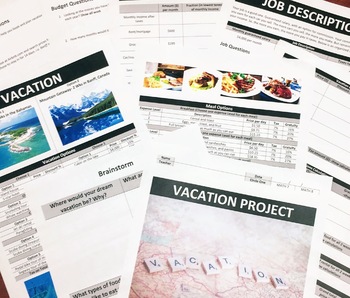Vacation Project (Percentages, Ratios)- 7th Grade
Project-Based Rigor
117 Followers
Grade Levels
6th - 8th
Subjects
Resource Type
Standards
CCSS6.EE.A.2c
CCSS6.EE.B.6
CCSS7.EE.B.4
CCSS6.RP.A.3c
CCSS7.RP.A.2c
Formats Included
- PDF
- Internet Activities
Pages
11 pages
Project-Based Rigor
117 Followers
Compatible with Digital Devices
The Teacher-Author has indicated that this resource can be used for device-based learning.
What educators are saying
I'm using this with a student I tutor privately. Found it very effective and engaging! Real-world budgeting was very eye opening for her.
I used this in my math support class and it took us a couple weeks of working through problems. It was a great way for them to understand what it would cost in real life, and what actually budgeting for a vacation would look like. I will definitely reuse this next year.
Also included in
- 6 Projects for the price of less than 4.Includes:- TinkerCAD Project (Into to TinkerCAD/Volume) - TinkerCAD Project (Volume/Scale Factor)- Vacation Project (Percentages)- Sticker Project (Circumference/Area of Circles)- Cookie Project (Surface Area/Volume of Cylinders)- Brownie Company Project (ReviPrice $10.00Original Price $15.00Save $5.00
Description
Great project that allows students to plan their dream vacation.
The students:
- Get a brief introduction on shortcuts with finding percentages
- Plan it out,
- Find overall expense
- Determine their income
- Examine monthly expenses
- Budget for the vacation.
Throughout the project, they answer questions, research online, and interview someone. Students work at their own pace!
They work heavily with
- Percentages: discount, tax, gratuity, commission, ratios, parts of whole.
- They also substitute into an equation
- Create a circle graph
- Use logic to solve problems that pertain to their own life.
Please leave feedback!
Total Pages
11 pages
Answer Key
N/A
Teaching Duration
N/A
Last updated May 15th, 2019
Report this resource to TPT
Reported resources will be reviewed by our team. Report this resource to let us know if this resource violates TPT’s content guidelines.
Standards
to see state-specific standards (only available in the US).
CCSS6.EE.A.2c
Evaluate expressions at specific values of their variables. Include expressions that arise from formulas used in real-world problems. Perform arithmetic operations, including those involving whole-number exponents, in the conventional order when there are no parentheses to specify a particular order (Order of Operations). For example, use the formulas V = s³ and A = 6 s² to find the volume and surface area of a cube with sides of length s = 1/2.
CCSS6.EE.B.6
Use variables to represent numbers and write expressions when solving a real-world or mathematical problem; understand that a variable can represent an unknown number, or, depending on the purpose at hand, any number in a specified set.
CCSS7.EE.B.4
Use variables to represent quantities in a real-world or mathematical problem, and construct simple equations and inequalities to solve problems by reasoning about the quantities.
CCSS6.RP.A.3c
Find a percent of a quantity as a rate per 100 (e.g., 30% of a quantity means 30/100 times the quantity); solve problems involving finding the whole, given a part and the percent.
CCSS7.RP.A.2c
Represent proportional relationships by equations. For example, if total cost 𝘵 is proportional to the number 𝘯 of items purchased at a constant price 𝘱, the relationship between the total cost and the number of items can be expressed as 𝘵 = 𝘱𝘯.






